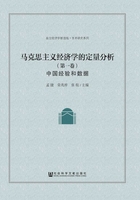
参考文献
[1]白暴力:《“价值转形问题”研究的三个学术基础》,《经济评论》2005年第4期。
[2]丁堡骏:《马克思劳动价值理论与当代现实》,经济科学出版社,2005。
[3]国家统计局国民经济核算司编著《中国2007年投入产出表编制方法》,中国统计出版社,2008。
[4]罗默:《马克思主义经济理论的分析基础》,汪立鑫等译,上海人民出版社,2007。
[5]马克思:《资本论》第3卷,人民出版社,1975,第162页。
[6]马艳、严金强:《转形问题的理论分析及动态价值转形模型的探讨》,《马克思主义研究》2010年第9期。
[7]荣兆梓:《马克思转形模型的技术结构与转形问题的症结》,《马克思主义研究》2010年第9期。
[8]斯拉法:《用商品生产商品:经济理论批判绪论》,巫宝三译,商务印书馆,1963。
[9]余斌:《从斯蒂德曼的非难看劳动价值理论及价值转形问题的计算》,《教学与研究》2007年第3期。
[10]郇中丹、张忠任:《关于BSZ转形模型存在唯一正解的充要条件》,《海派经济学》2009年第5期。
[11]张忠任:《百年难题的破解》,人民出版社,2004。
[12]张忠任:《论从投入产出表估算各部门劳动价值量的可能性》,载吴启富、刘黎明编《2007年中日经济统计学国际会议论文集》,首都经济贸易大学出版社,2007。
[13]Campbell,A.,“The Transformation Problem:A Simple Presentation of the ‘New Solution’,” Review of Radical Political Economics,29(1997):59-69.
[14]Chilcote,E.B.,Inter Industry Structure,Relative Prices,and Productivity:An Input-output Study of the US and OECD Countries(Ph.D.Dissertation,New School for Social Research,1997).
[15]Duménil,G.& Lévy,D.,“The Profit Rate:Where and How Much Did It Fall? Did It Recover?—USA 1948-2000,” Review of Radical Political Economics,34(2002):437-461.
[16]Duménil,G.,“Beyond the Transformation Riddle:A Labor Theory of Value,”Science and Society,47(1983):427-450.
[17]Foley,D.,“The Value of Money,the Value of Labor Power and the Marxian Transformation Problem,” Review of Radical Political Economics,14(1982):37-47.
[18]Fujimori,Y.,“Wage-prot Curves in a von Neumann-Leontief Model:Theory and Computation of Japan's Economy 1970-1980,” Journal of Applied Input-Output Analysis,1(1992):43-54.
[19]Fujimori,Y.,“On a Recent Discussion of the Transformation Problem(Notes),” Journal of Economics(Josai University),21(1985):443-451.
[20]Kliman,A.,Reclaiming Marx's Capital:A Refutation of the Myth of Inconsistency (New York:Lexington Books,2007).
[21]Leontief,W.,“Quantitative Input and Output Relations in the Economic System of the United States,” The Review of Economic Statistics,18(1936):105-125.
[22]Li,Bangxi,“Fixed Capital and Wage-profit Curves a la von Neumann-Leontief:China's Economy 1987-2000,” Research in Political Economy,29(2014):75-93.
[23]Lipietz,A.,“The So-called Transformation Problem Revisited,” Journal of Economic Theory,26(1982):59-88.
[24]Lü,Z.,Development and Application of the China Multi-area Multisectors Dynamic Model in Consideration of the Gap between Areas(in Japanese)(Ph.D.Dissertation,University of Tokyo,2007).
[25]Mage,S.H.,The Law of the Falling Tendency of the Rate of Profit:Its Place in the Marxian Theoretical System and Relevance to the U.S.Economy(Ph.D.Dissertation,Columbia University,1963).
[26]Mariolis,T.& G.Soklis,“On Constructing Numeraire-free Measures of Price-value Deviation:A Note on the Steedman-Tomkins Distance,” Cambridge Journal of Economics,35(2010):613-618.
[27]Mariolis,T.,& L.Tsoulfidis,“Decomposing the Changes in Production Prices into ‘Capital-intensity’ and ‘Price’ Effects:Theory and Evidence from the Chinese Economy,” Contributions to Political Economy,28(2009):1-22.
[28]Morishima,M.& F.Seton,“Aggregation in Leontief Matrices and the Labour Theory of Value,” Econometrica,29(1961):203-220.
[29]Morishima,M.,Marx's Economics:A Dual Theory of Value and Growth(London:Cambridge University Press,1973).
[30]Morishima,M.& G.Catephores,Value,Exploitation and Growth(New York:McGraw-Hill,1978).
[31]Ochoa,E.,Labor Values and Prices of Production:An Inderindustry Study of the U.S.Economy,1947–1972(Ph.D.Dissertation,New School for Social Research,1984).
[32]Okishio,N.& T.Nakatani,“Prot and Surplus Labor—Considering the Existence of the Durable Equipments,” The Economic Studies Quarterly,26(1975):90-96.
[33]Okishio,N.,“On Marx's Production Prices,” Keizaigaku Kenkyu,19(1972):38-63.
[34]Okishio,N.,“Dimensional Analysis in Economics,” 1982,in Flascher,P.(ed.),Essays on Political Economy (Frankfurt:Lang,1993).
[35]Okishio,N.& T.Nakatani,“A Measurement of the Rate of Surplus Value,” 1985,in Flascher,P.(ed.),Eassys on the Political Economy (Frankfurt:Lang,1993).
[36]Samuelson,P.A.,“Understanding the Marxian Notion of Exploitation:A Summary of the So-called Transformation Problem between Marxian Values and Competitive Prices,” Journal of Economic Literature,9(1971):399-431.
[37]Seton,F.,“The Transformation Problem,” The Review of Economic Studies,24(1957):149-160.
[38]Shaikh,A.,“Marx's Theory of Value and the Transformation Problem,” in Schwartz,J. (ed.),The Subtle Anatomy of Capitalism(Santa Monica,Canada:Goodyear,1977).
[39]Shaikh,A.,“The Transformation from Marx to Sraffa,” 1984,in Freeman,A.and E.Mandel(eds.),Ricardo,Marx and Sraffa (London:Verso,1985).
[40]Steedman,I.,Marx after Sraffa (London:New Left Books,1977).
[41]Steedman,I.& J.Tomkins,“On Measuring the Deviation of Prices from Values,” Cambridge Journal of Economics,22(1998):379-385.
[42]Tsoulfidis,L.& T.Maniatis,“Values,Prices of Production and Market prices:Some More Evidence from the Greek Economy,” Cambridge Journal of Economics,26(2002):359-369.
[43]Tsoulidis,L.,& D.M.Rieu,“Labor Values,Prices of Production,and Wage-prot Rate Frontiers of the Korean Economy,” Seoul Journal of Economics,19(2006):275-295.
[44]Tsoulfidis,L.,“Price-value Deviations:Further Evidence from Input-Output Data of Japan,” International Review of Applied Economics,22(2008):707-724.
[45]Zachariah,D.,“Labour Value and Equalisation of Profit Rates:A Multi-country Study”,Indian Development Review,4(2006):1-21.
[1]特别感谢匿名评审人的意见和建议,当然文责自负。
[2]荣兆梓,安徽大学,教授;陈旸,安徽大学经济学院,讲师。
[3]本文中使用粗体符号表示向量或矩阵,下同。
[4]表面地看,理论模型的统一工资率与现实中具体劳动的工资差异有矛盾。但如果把工资差异理解为劳动强度和复杂程度的差异,即工资率更高的复杂劳动是倍加的简单劳动,那么,这个理论与现实的矛盾就可以消除。考虑到式(1)中的L向量必须是同质的社会劳动,这样的理解是公式内在一致性的必然要求。
[5]本文主要涉及单一产品生产下的静态转形模型,关于转形问题的动态模型可见Morishima和Catephores(1978)、Shaikh(1977)、Kliman(2007)、丁堡骏(2005)、马艳和严金强(2010)等。
[6]主张A体系的研究者阵容豪华,包括塞顿(Seton,1957)、森岛通夫(Morishima,1973)、萨缪尔森(Samuelson,1971)、斯蒂德曼(Steedman,1977)、置盐信雄(Okishio,1972)和罗默(Roemer,2007)等。近年来活跃于转形问题研究的我国学者白暴力(2005)、余斌(2007)等仍然延续了A体系的路径。
[7]藤森(1985)在批评“新解释”的理论观点时,曾经顺便指出,B体系还存在其他变形,并写出了与式(6)基本相同的公式,可惜他认为这些转形问题的解决方案不符合马克思的劳动力商品价值决定理论,因而是不足取的。
[8]马克思:《资本论》第3卷,人民出版社,1975,第159页;另见同书195~196页。
[9]“因为假定剩余价值率和工作日不变,并且因为这个假定也包含着工资不变,所以,一定量的可变资本表示一定量的被推动的劳动力,因此也表示一定量的物化劳动。”“这样一来,可变资本在这里(在工资已定时总是这样)成了一定量的总资本所推动的劳动量的指数”。参见马克思(1975)。
[10]例如Mage(1963),Duménil和Lévy(2002),Tsoulfidis和Rieu(2006)。
[11]关于劳动报酬差异(更高的工资)是否能代表劳动技能和强度差异,有一种观点认为工资水平差异反映的是劳动生产率的差异,而非技能、强度差异。而劳动生产率和该部门的机器化程度相关,因此工资水平反映的可能是该部门的机器化程度而非技能强度差异。我们计算了各部门使用的制造业产品和部门工资率之间的线性关系,发现2007年的r2=0.00107,可以认为这种相关性并不明显。
[12]农业劳动的人均报酬比建筑业要低得多,大约只相当于建筑业人均报酬的60%。但这个部门的市场化程度不高,农业生产又以家庭经营为主要形式,因此不具有典型性。
[13]这一建筑业城镇劳动人口数据与投入产出表中建筑业劳动报酬数据口径上的差异可能比想象的要小,按照国家统计局国民经济核算司编著的《中国2007年投入产出表编制方法》(中国统计出版社,2008),建筑业劳动报酬由资质内企业劳动报酬和资质外企业劳动报酬两部分组成。其中资质外企业数据是由资质内企业数据和经济普查资料推算的。翻阅经济普查资料,发现各地的资质外建筑企业地址几乎都在城镇及经济开发区,它们中绝大多数应该在城镇就业人口的统计范围之内。
[14]由于历年投入产出表的部门分类不同,本文将1990年、1992年、1995年表中的“公用事业及居民服务业”“文教卫生科研事业”“行政机关”三个部门从生产性部门剔除,将1997年、2000年表中的“卫生体育和社会福利业”“教育文化艺术及广播电影电视业”“行政机关及其他行业”剔除,将2002年、2005年表中的“教育”“卫生、社会保障和社会福利业”“公共管理和社会组织”剔除。此外,1990年的投入产出表在新增值中统计了“福利基金”,本文将其作为工资的一部分计入生产性工人的工资。
[15]限于篇幅,此处未列示具体计算结果,有兴趣的读者可以向笔者索取。
[16]由于本文计算的是用总产出衡量的商品价格,因此产量对角矩阵实际上就是单位矩阵。关于MAD、MAWD统计量的讨论见Mariolis和Soklis(2010)。对NVD统计量的不同观点见Steedman和Tomkins(1998)。
[17]除了使用的计算体系不一样以外,Mariolis和Tsoulfidis(2009)所使用的数据似乎也存在一定的问题。例如他们的计算中除了化学工业以外,还包含制药业和橡胶与塑料制品业;除了交通运输制造业以外,还包含船舶维修和制造业。而这在官方的40部门投入产出表中是不包含的。另外,他们的研究中将教育、卫生和社会服务等部门也视为参与生产价格的形成,这与本文的方法也不同。
[18]考虑固定资本时,B-1子体系面临着斯蒂德曼所谓的“负价值问题”,而B-2子体系的支持者认为,联合生产和固定资本问题在B-2计算框架中可以很好地得到解决。